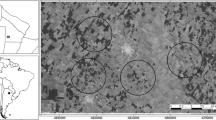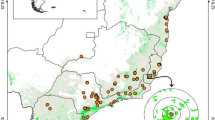Abstract
Both forest fragmentation and overhunting have profound effects on the structure of large-vertebrate assemblages in neotropical forests. However, the long-term value of habitat fragments for forest mammals remains poorly understood and few regional scale studies have replicated sampling across spatially independent landscapes. Here, we assess the species occupancy and abundance of midsized to large-bodied mammals within three neighbouring Amazonian forest landscapes varying widely in extent of forest cover. One of these consisted of forest fragments surrounded by semi-natural scrub savannahs that had been occupied by paleoindian populations for at least 7,000 years, whereas forest cover in the other two landscapes was either variegated or continuous. Data on species occurrence and abundance from diurnal and nocturnal line-transect surveys and local interviews in each landscape were used to examine the effects of forest cover and hunting pressure on mammal persistence within forest patches. The extent of forest cover was a key determinant of species persistence across the three landscapes, but populations of large-bodied species were either reduced or driven to local extinction by hunting even in the most forested and least fragmented landscape. Many game and non-game species persisted in forest isolates, even though, individually, these were likely too small to support viable populations. This study indicates that even small, long-term forest fragments may retain significant conservation value if they can be managed within the context of enhanced connectivity across wider fragmented landscapes.






Similar content being viewed by others
References
Albernaz ALKM (2001) Zoneamento da região de Alter do Chão, Pará: um exercício de planejamento para uma Unidade de Conservação de uso indireto. Doctoral Thesis, INPA/UFAM
Almeida-Neto M, Guimarães PR Jr, Lewinsohn TM (2007) On nestedness analysis: rethinking matrix temperature and anti-nestedness. Oikos 116:716–722
Altrichter M, Boaglio GI (2004) Distribution and relative abundance of peccaries in the Argentine Chaco: associations with human factors. Biol Conserv 116:217–225
Andrén H (1994) Effects of habitat fragmentation on birds and mammals in landscapes with different proportions of suitable habitat: a review. Oikos 71:355–366
Atmar W, Patterson BD (1993) The nestedness temperature calculator: a visual basic program, including 294 presence–absence matrices. AICS Research Inc, University Park
Azevedo-Ramos C, Amaral BD, Nepstad DC et al (2006) Integrating ecosystem management, protected areas, and mammal conservation in the Brazilian Amazon. Ecol Soc 11:17
Bates HW (1892) A naturalist on the river Amazon. Murray, London
Baum KA, Haynes KJ, Dillemuth FP et al (2004) The matrix enhances the effectiveness of corridors and stepping stones. Ecology 85:2671–2676
Bennett EL (2002) Is there a link between wild meat and food Security? Conserv Biol 16:590–592
Bodmer RE (1995) Managing Amazonian wildlife: biological correlates of game choice by detribalized hunters. Ecol Appl 5:872–877
Bodmer RE, Eisenberg FF, Redford KH (1997) Hunting and the likelihood of extinction of Amazonian mammals. Conserv Biol 11:460–466
Broadbent EN, Asner GP, Keller M et al (2008) Forest fragmentation and edge effects from deforestation and selective logging in the Brazilian Amazon. Biol Conserv 141:1745–1757
Brown JH (1971) Mammals on mountain tops: nonequilibrium insular biogeography. Am Nat 105:467–478
Chetkiewicz CB, St. Clair CC, Boyce MS (2006) Corridors for conservation: integrating pattern and process. Annu Rev Ecol Evol Syst 37:317–342
Chiarello AG (2000) Density and population size of mammals in remnants of Brazilian Atlantic Forest. Conserv Biol 14:1649–1657
Colwell RK (2005) EstimateS: statistical estimation of species richness and shared species from samples. Version 7.5. http://www.viceroy.eeb.uconn.edu/EstimateS
Cowlishaw G (1999) Predictiong the pattern decline of African primate diversity: an extinction debt from historical deforestation. Conserv Biol 13:1183–1193
Cullen-Junior L, Bodmer RE, Pádua CV (2000) Effects of hunting in habitat fragments of the Atlantic forests, Brazil. Biol Conserv 95:49–56
Dale VH, Pearson SM, Offerman HL et al (1994) Relating patterns of land-use change to faunal biodiversity in the central Amazon. Conserv Biol 8:1027–1036
Debinski DM (2006) Forest fragmentation and matrix effects: the matrix does matter. J Biogeogr 33:1791–1792
Debinski DM, Holt RD (2000) A survey and overview of habitat fragmentation experiments. Conserv Biol 14:342–355
Eisenberg JF, Redford KH (1999) Mammals of the Neotropics. The Central Neotropics, vol 3. The University of Chicago Press, Chicago
Estrada A, Coates-Estrada R, Meritt D Jr (1994) Non flying mammals and landscape changes in the tropical rain forest region of Los Tuxtlas, Mexico. Ecography 17:229–241
Fa JE, Brown D (2009) Impacts of hunting on mammals in African tropical moist forests: a review and synthesis. Mammal Rev 39:231–264
Fahrig L (2003) Effects of habitat fragmentation on biodiversity. Annu Rev Ecol Evol Syst 34:487–515
Fearnside PF (2007) Brazil’s Cuiabá-Santarém (BR-163) highway: the environmental cost of paving a soybean corridor through the Amazon. Environ Manage 39:601–614
Feeley KJ, Terborgh JW (2008) Direct versus indirect effects of habitat reduction on the loss of avian species from tropical forest fragments. Anim Conserv 11:353–360
Ferrari SF, Iwanaga S, Ravetta AL (2003) Dynamics of primate communities along the Santarém-Cuiabá highway in south-central Brazilian Amazonia. In: Marsh LK et al (eds) Primates in fragments. Ecology and conservation. Kluwer Academic/Plenum Publishers, New York
Ferraz G, Nichols JD, Hines JE et al (2007) Effects of patch area and isolation on Amazon birds. Science 315:238–240
Fischer J, Lindenmayer DB (2007) Landscape modification and habitat fragmentation: a synthesis. Global Ecol Biogeogr 16:265–280
Galetti M, Giacomini HC, Bueno RS et al (2009) Priority areas for the conservation of Atlantic forest large mammals. Biol Conserv 143:1–12
Giraudoux P (2009) pgirmess: data analysis in ecology. R package version 1.3.8. http://www.perso.orange.fr/giraudoux/
Goslee SC, Urban DL (2007) The ecodist package for dissimilarity-based analysis of ecological data. J Stat Softw 22:1–19
Hanski I, Ovaskainen O (2000) The metapopulation capacity of a fragmented landscape. Nature 404:755–758
Henle K, Davies KF, Kleyer M et al (2004) Predictors of species sensitivity to fragmentation. Biodivers Conserv 13:207–251
Laurance WF (1991) Ecological extinction Australian correlates of proneness in Tropical Rain Forest mammals. Conserv Biol 5:79–89
Laurance WF (2008) Theory meets reality: how habitat fragmentation research has transcended island biogeographic theory. Biol Conserv 141:1731–1744
Laurance WF, Lovejoy TE, Vasconcelos HL et al (2002a) Ecosystem decay of Amazonian forest fragments: a 22-year investigation. Conserv Biol 16:605–618
Laurance WF, Albernaz AKM, Schroth G et al (2002b) Predictors of deforestation in the Brazilian Amazon. J Biogeogr 29:737–748
Laurance WF, Laurance SG, Hilbert DW (2008) Long-term dynamics of a fragmented rainforest mammal assemblage. Conserv Biol 22:1154–1164
Lees AC, Peres CA (2009) Gap-crossing movements predict species occupancy in Amazonian forest fragments. Oikos 118:280–290
Lopes MA, Ferrari SF (2000) Effects of human colonization on the abundance and diversity of mammals in Eastern Brazilian Amazonia. Conserv Biol 14:1658–1665
Martins MM (2005) Density of primates in four semi-deciduous forest fragments of São Paulo, Brazil. Biodivers Conserv 14:2321–2329
Metzger JP, Décamps H (1997) The structural connectivity threshold: an hypothesis in conservation biology at the landscape scale. Acta Oecol 18:1–12
Michalski F, Peres CA (2005) Anthropogenic determinants of primate and carnivore local extinctions in a fragmented forest landscape of southern Amazonia. Biol Conserv 124:383–396
Michalski F, Peres CA (2007) Disturbance-mediated mammal persistence and abundance-area relationships in Amazonian forest fragments. Conserv Biol 21:1626–1640
Miranda IS (1993) Estrutura do estrato arbóreo do cerrado Amazônico em Alter-do-Chão, Pará. Rev Brasil Bot 16:143–150
Patterson B, Ceballos G, Sechrest W et al (2003) Digital distribution maps of the mammals of the western hemisphere. Version 1.0. NatureServe, Arlington
Peres CA (1999) General guidelines for standardizing line-transect surveys of Tropical Forest Primates. Neotrop Primates 7:11–16
Peres CA (2000) Effects of subsistence hunting on vertebrate community structure in Amazonian forests. Conserv Biol 14:240–253
Peres CA (2001) Synergistic effects of subsistence hunting and habitat fragmentation on Amazonian Forest Vertebrates. Conserv Biol 15:1490–1505
Peres CA, Palacios E (2007) Basin-wide effects of game harvest on vertebrate population densities in Amazonian forests: implications for animal-mediated seed dispersal. Biotropica 29:304–315
Peres CA, Gardner TA, Barlow J et al (2010). Biodiversity conservation in human-modified Amazonian forest landscapes. Biol Conserv. doi:10.1016/j.biocon.2010.01.021
R Development Core Team (2008) R: A language and environment for statistical computing. R Foundation for Statistical Computing, Vienna. ISBN 3-900051-07-0. http://www.R-project.org
Ravetta AL, Ferrari SF (2009) Geographic distribution and population characteristics of the endangered white-fronted spider monkey (Ateles marginatus) on the lower Tapajós River in central Brazilian Amazonia. Primates 50:261–268
Robinson JG, Redford KH (1991) Sustainable harvest of neotropical forest mammals. In: Robinson JG, Redford KH (eds) Neotropical wildlife use and conservation. Chicago University Press, Chicago
Roosevelt AC, Housley RA, da Silveira MI et al (1991) Eighth millennium pottery from a prehistoric shell midden in the Brazilian Amazon. Science 254:1621–1624
Roosevelt AC, Lima da Costa M, Machado CL et al (1996) Paleo-Indian cave dwellers in the Amazon: the peopling of the Americas. Science 272:373–384
Sanaiotti TM, Martinelli LA, Victoria RL et al (2002) Past vegetation changes in Amazon savannas determined using carbon isotopes of soil organic matter. Biotropica 34:2–16
Serena M (1984) Distribution and habitats of parthenogenetic and sexual Cnemidophorus lemniscatus (Sauria: Teiidae) in Surinam. Copeia 3:713–719
Soares-Filho BS, Nepstad DC, Curran LM et al (2006) Modeling conservation in the Amazon basin. Nature 440:520–523
Stone AI, Lima EM, Aguiar GFS et al (2009) Non-volant mammalian diversity in fragments in extreme eastern Amazonia. Biodivers Conserv 18:1685–1694
Turner IM, Corlett RT (1996) The conservation value of small, isolated fragments of lowland tropical rain forest. Trends Ecol Evol 11:330–333
Venables WN, Ripley BD (2002) Modern applied statistics with S, 4th edn. Springer, New York
Watling JI, Donnelly MA (2006) Fragments as islands: a synthesis of faunal responses to habitat patchiness. Conserv Biol 20:1016–1025
Watson DM (2003) The ‘standardized search’: an improved way to conduct bird surveys. Austral Ecol 28:515–524
Acknowledgments
We are grateful for the field assistance of Ediwaldo Vasconcelos, Donildo, Juvenal and Herrison, and to the family of Juci and Laudeco Sardinha and the villagers of Alter-do-Chão who made our field work much more pleasant. We thank Gonçalo Ferraz and two anonymous reviewers for their comments on the manuscript, Vitor Landeiro for assistance with the statistical analyses, and Juliana Schietti and Ralph Trancoso for their GIS assistance. The study was funded by grants from the Brazilian Research Council (CNPq) to APL and WEM, and a scholarship from the IEB/Moore Foundation Beca Program (B/2006/01/BMP/11) and CNPq to RS.
Author information
Authors and Affiliations
Corresponding author
Rights and permissions
About this article
Cite this article
Sampaio, R., Lima, A.P., Magnusson, W.E. et al. Long-term persistence of midsized to large-bodied mammals in Amazonian landscapes under varying contexts of forest cover. Biodivers Conserv 19, 2421–2439 (2010). https://doi.org/10.1007/s10531-010-9848-3
Received:
Accepted:
Published:
Issue Date:
DOI: https://doi.org/10.1007/s10531-010-9848-3




